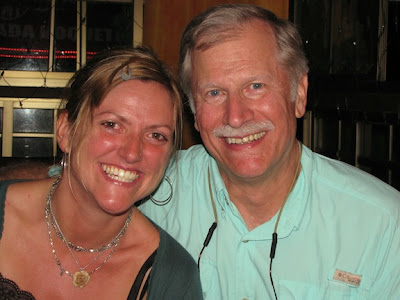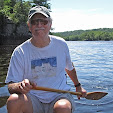Para mis amigos mexicanos, panameños, costarricenses y ustedes de otras partes del mundo en que no cuentan usteds con el asombro de la nieve, aquí tenemos unas imágenes de nuestro hermoso paisaje de blanco después de nuestra primera tempestad invernal.
When we northerners visit your countries' landscapes, warm year-round with greens, browns and all the floral colors, with those plants and animals we've never seen before, it seems so fascinating, so exotic. For you, though, it's what you see every day; you might take it for granted. But if you could come here on a winter day like this, I know you'd be struck by that same kind of enchantment.
Cuando nosotros norteños visitan los paisajes de sus países calentados por colores de verde, de marrón y de flor, con todas las plantas y animales que nunca hemos visto, nos parece muy fascinantes, muy exóticos. Sin embargo, para ustedes, eso es lo que ven cada día; tal vez se lo den por sentado. Pero, si ustedes pueden venir acá durante un día invernal como este, es cierto que se quede encantados.
 |
| Our sidewalks have walls. |
 |
| Some people's cars get snowed or plowed in. |
 |
| These bikes won't roll today. |
 |
| Sure beats shoveling! |
 |
| Friends and neighbors pitch in. |
 |
| Tree limbs are etched in black and white. |
 |
| The frozen Mississippi River, just a block from home. |
SOME OBSERVATIONS ABOUT SNOW:
The equivalent of one inch (2.5 centimeters) of liquid precipitation—not uncommon for a summer storm—can result in as much as 20 inches (50 cm) of snow. That's how much we got from the winter storm that passed through here yesterday. For the whole winter here in east central Minnesota, we usually get about 48 inches (1.2 m), but it rarely gets that deep because some of it melts now and then.
When it settles on the ground, snow can be wet or dry, as light as feathers or as heavy as sand. Generally, the flakes are those exquisite, iconic, hexagonal ice crystals, but they can also take shape as plates, shards (needles) or little round pellets we call corn snow. It all depends on the air temperature, how and where the crystals form and several other conditions.
When it's the light, dry kind, snow is fairly easy to walk or drive through; you can shuffle through it like piles of dry autumn leaves, except the sound is softer, like the slightest whisper. But when the snow's heavy and wet, it's harder to navigate, and it can get pretty messy.
Often, after a big snow storm, a mass of brutally cold arctic air will sweep down from the northwest as it has today. This air is very dry, and changes the consistency of the snow so it crunches and squeaks like Styrofoam when you walk on it.
After a few cars or trucks have driven over snow, it compacts into ice. It can be extremely slippery. Those of us who have lived here all our lives have learned how to drive in snow fairly safely. Young drivers, people who are impatient and recent immigrants from snowless climes have a much harder time getting around.
After yesterday's big storm, the city's big snow plows came through the streets, moving the snow to piles along the sides. For the first day, people can't park their cars along the street. If the do, they either get towed away or nearly buried by the plows.
The plowing angers people who have just shoveled out their sidewalks and driveways, since the new piles cover up the areas they've just shoveled. Plows mix up the snow, squeezing much of the air out of it and making it dense and very heavy.
A big winter storm changes the way people here think about life (not unlike, I suppose, when you experience a flood or a hurricane in your country). The whole community comes outside to see what's happened, and they all pitch in and help each other. It's a nice feeling, one I wish we could share all the time.
But snow's more than just a challenge for us; it's also a delight. One of our favorite Christmas songs is called I'm Dreaming of a White Christmas. And this is just what we do. We hope for snow, so we can enjoy its beauty, so we can play in it, and so the runners of Santa Claus's sleigh will have something slippery to slide on when it lands on each child's rooftop.
We learn, when we're children, to associate snow with play. We roll around in it and throw it; we make "snow angels" by lying in the snow and then sweeping our arms and legs; we dig tunnels into the huge piles left by shoveling and plowing; we build forts and igloos; we sculpt it into statues, we slide and ski on it.
If it's the right consistency, you can pick up a handful of snow and shape it into a ball. We love having "snowball fights," throwing them at each other. Usually they break apart when they hit you, and sometimes the pieces go down your neck inside your jacket. That's almost a funny as it is cold!
If you've never experienced snow, you can't imagine how beautiful it is. It's amazing seeing everything covered in white. Lawns, streets, sidewalks, parking lots, the roofs of buildings—all pure white. Even the trees wear cloaks of white. Those that have shed their leaves for winter have the tops of each dark brown or gray branch crisply etched in white.
The evergreens hold more snow, though often their branches droop under its weight. And—even more stunning than the whiteness,—when the snow is fresh, the sun catches the reflective surfaces of each tiny water crystal, making all of it sparkle like a blanket of diamonds.
I wish you all could see this. Would you like to experience a northern winter? I sincerely hope you get the chance to do so one day!













































